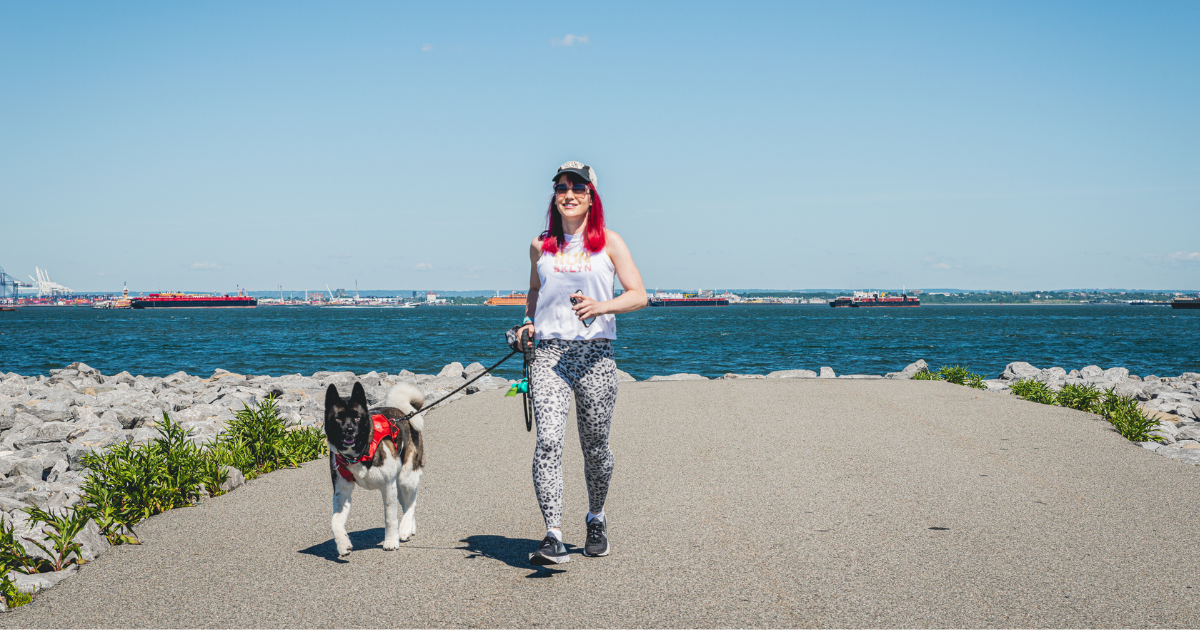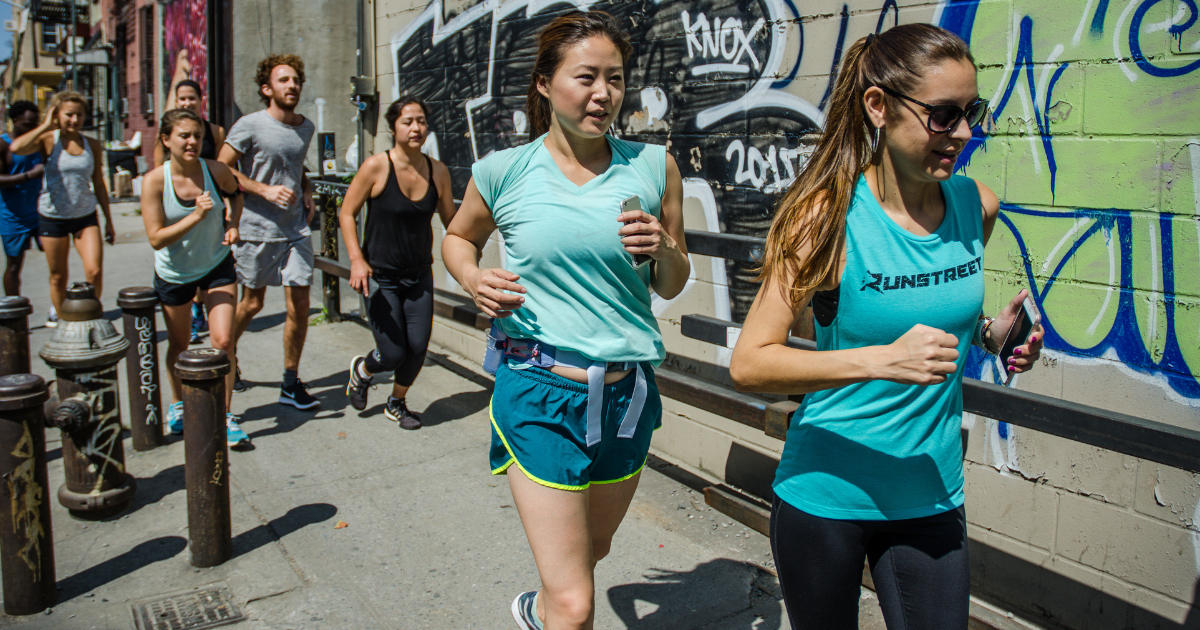Guide to Running with Your Dog
Photo by Marques Jackson Photography of Runstreet founder Marnie and her dog, Kiyoshi.
By Marissa Del Mistro
Running with your dog is a great way to exercise together and bond with your pup. Dogs can be the best running partners — they are always enthusiastic, won't complain, and will most likely enjoy running as much as you do. If you'd like to start running with your dog, it just requires a little training, practice, and the right running gear for your four-legged running buddy. Before you get started running with your pup, here are some things to consider:
Best Dog Breeds for Running
The first thing to do when running with your dog is to consider the breed — or mix — of the dog you have. For example, if you are a long-distance runner, your best running candidates will be dogs such as Australian Shepherds, Siberian Huskies, various retrievers, German Shepherds, Dalmatians, Dobermans, Border Collies, Rhodesian Ridgebacks, Standard Poodles, and other medium to large, athletic breeds that are built for running. On the other hand, if you prefer short runs, your best breeds or mixes would be dogs that like shorter distances, such as Greyhounds or Beagles.
Check out our article on the Best Dog Breeds for Running for more insights into which breeds are born to run.
Some dogs should generally avoid running outside of fun playtime spurts. These are dogs with short muzzles and small respiratory tracts, also called brachycephalic breeds. Their anatomy makes breathing hard (like Pugs, various bulldogs, Boston Terriers, etc.), and dogs with short legs, like Corgis, Basset Hounds, and Dachshunds.
Senior dogs and puppies should also refrain from running for extended periods. Older dogs are more prone to conditions like arthritis, stiffness, pain, tiredness, or joint pain, which can cause long-term pain. You will know your dog and should look for signs of pain, but typically dogs aren't able to run long distances after they hit age 7 for big dogs and 10 for smaller dogs.
Vets advise that puppies should not run as their bones and joints are still developing, so it's best to wait until they're 1 to 2 years old. However, large dog breeds tend to grow more slowly, so they may be able to start running at 2 or even 3 years old.
Running with Your Dog - What You Need to Know
Do Not Feed Your Dog Before or After Running
Just like us humans, you should be mindful of your dogs' food intake pre- and post-run to avoid cramping, stomach pain, or conditions that are dire such as gastric dilatation and volvulus syndrome. Do not feed your dog within an hour of running and wait at least two hours after eating before running with your dog.
Hydration
Like humans, dogs may need to drink water during their runs, so take frequent water breaks. Bring a collapsible bowl or dog water bottle on the run for your pup. When you get home, avoid giving them praise with a treat right away and instead give them praise and let them cool down at least 20 minutes before having a treat.
Extreme Temperatures
Generally, avoid running with your dog in extreme heat or cold. If the temperature and humidity add up to 150 when combined, it's too hot to run with your pup. The hot asphalt can be painful for your canine companion so avoid it or put lightweight boots on your pup's paws to protect them.
Some dogs are specially equipped for extreme weather. For example, northern breeds like Siberian Huskies and Akitas love the cold, while breeds from Africa, like Rhodesian Ridgebacks and Basenjis, can withstand more heat.
In the winter, if the weather is very cold or below freezing, your dog can get frostbite or salt poison on their paws. You can protect your running buddy with booties for your dog's paws and a jacket if your dog is short-haired or prone to getting cold.
In hot weather, excessive heat can affect dogs with issues like dehydration, heatstroke, and paw damage. Signs of heat issues include slowing down, lolling tongue, wobbly legs, foaming mouth, and glazed eyes. If your dog overheats while running, immediately stop running and seek cooler temperatures in the shade or preferably AC, and allow your dog plenty of water to cool down. If your dog has heat exhaustion, seek veterinary assistance immediately.
Preparing Your Pooch to Run
Just like humans can't run long distances without training, it's the same with dogs! Even if your dog is healthy and enjoys playing and running, your pup should still build strength and stamina gradually. You should also help your dog warm up by starting with a quick walk or slow jog to warm up and avoid injury.
Here is some gear that can help you both enjoy a smooth run - a harness, running belt to attach the leash, poop bags, and a collar with ID. You can get a hands-free leash that attaches to your waist for easy running when your dog is trained to stay next to you.
A Program for Running With Your Dog
Like humans, routine is essential for dogs. You can start running with your dog at a slow pace for short distances and increase your mileage by 2 to 5 percent every week. Eventually, your dog will get used to 3 to 5 runs per week.
Running with your dog off-leash is risky. Dogs should have a leash on when running for the safety of the dog and others. Regardless of how well-trained your dog is, there are many unknown variables when running outside. Plus, when your dog is attached to you, it lets you closely monitor their physical and emotional health to ensure they're doing fine on the run.
Benefits of Running with Your Dog
There are many benefits of running with your dog. Here are some of them:
Active dogs live happier lives. Even some of the best-behaved dogs can get reckless when not exercising regularly. Running for dogs is like Christmas: they hear new things, smell new smells, and meet many new dog friends. Active dogs tend to live longer and enjoy extensive simulation. As with people, many dogs suffer from obesity and can develop severe health conditions as a result. Running helps keep your dog at a healthy weight.
Bonding with your furry bestie. Dogs love you unconditionally. They love spending time with you, and when they have a particular time to look forward to with just the two of you, it will help increase your bond.
Physical health benefits. Running works different muscles in your pup and is more intense than walking, which gives your dog a stronger heart, muscles, and lungs. Maintaining a healthy weight will also help your dog avoid weight-related issues.
Vets Know Best
Regardless of your dog's breed, age, and health, it is best to speak to your veterinarian to determine if and how to safely run with your pup. The vet can caution you on what to do and avoid based on your dog's breed and background. Speaking to the vet before starting any new routine is always wise.
Do you enjoy running with your dog? Tag @Runstreet on Instagram to share your running adventures and get cheered on.😊
Related Posts: Running with Rescue Dogs Tips & Stories, 20 Best Dog-Friendly Places n NYC, Best Dog Breeds for Running
Marissa Del Mistro is a writer, editor, and always on the hunt for the perfect workout. Marissa absolutely loves trail running, dancing, and cycling. When she’s not writing, Marissa loves cooking, podcasts, traveling, and exploring her home in the beautiful unceded Coast Salish Territory of the Lekwungen and W̱SÁNEĆ nations.





